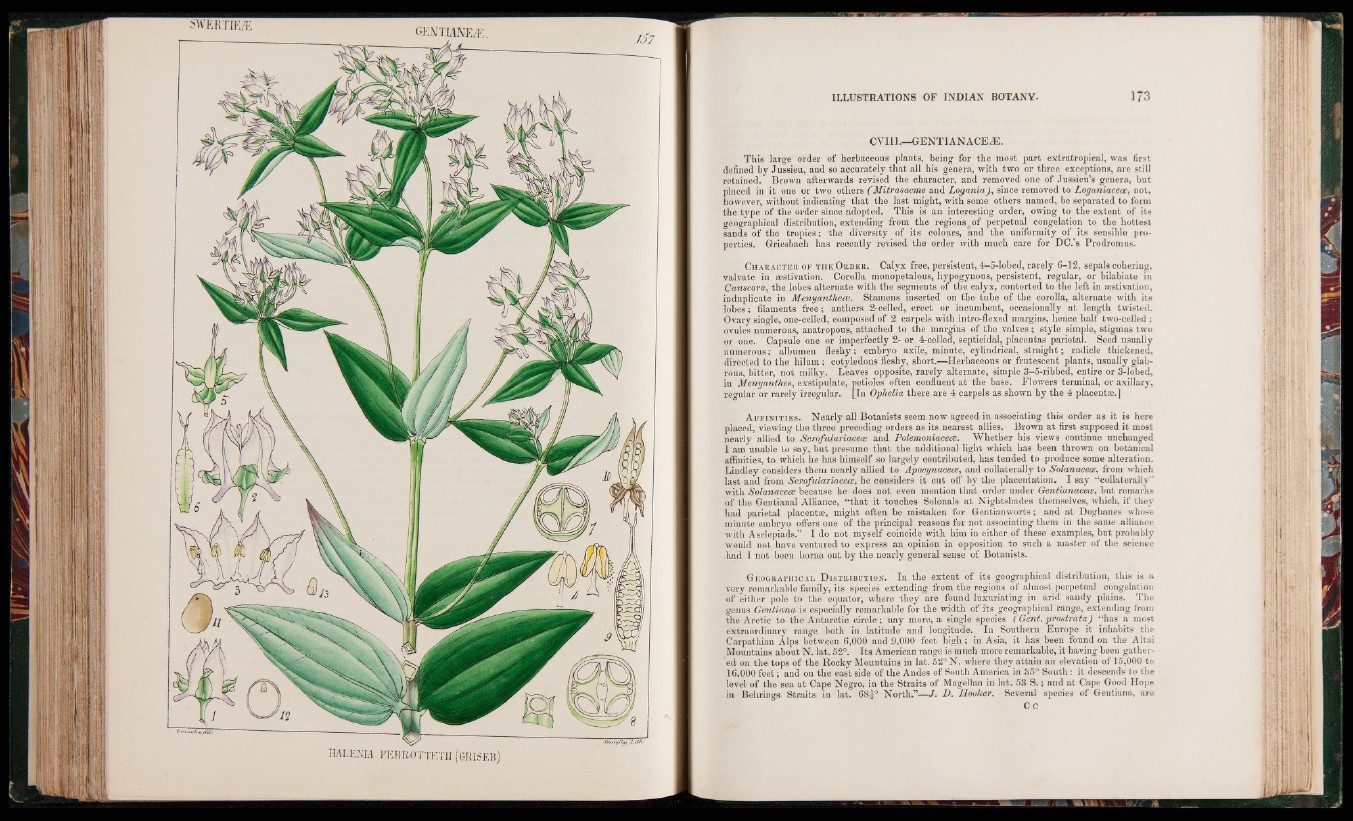
SWEBTÎEÆ
CVIII.—GENTIANACEZE.
This large order of herbaceous plants, being for the most part extratropical, was first
defined by Jussieu, and so accurately that all his genera, with two or three exceptions, are still
retained. Brown afterwards revised the character, and removed one of Jussieu’s genera, but
placed in it one or two others (Mitrasacme and Logania)y since removed to Loganiacece, not,
however, without indicating that the last might, with some others named, be separated to form
the type of the order since adopted. This is an interesting order, owing to the extent of its
geographical distribution, extending from the regions of perpetual congelation to the hottest
sands of the tropics; the diversity of its colours, and the uniformity of its sensible properties.
Griesbach has recently revised the order with much care for DC.’s Prodromus.
Character of the Order. Calyx free, persistent, 4-5-Iobed, rarely 6-12, sepals cohering,
valvate in aestivation. Corolla monopetalous, hypogynous, persistent, regular, or bilabiate in
Canscora, the lobes alternate with the segments of the calyx, contorted to the left in aestivation,
induplicate in Menyanthece. Stamens inserted on the tube of the corolla, alternate with its
lobes; filaments free; anthers 2-celled, erect or incumbent, occasionally at length twisted.
Ovary single, one-celled, composed of 2 carpels with intro-flexed margins, hence half two-celled ;
ovules numerous, anatropous, attached to the margins of the valves; style simple, stigmas two
or one. Capsule one or imperfectly 2- or 4-celled, septicidal, placentas parietal. Seed usually
numerous; albumen fleshy; embryo axile, minute, cylindrical, straight; radicle thickened,
directed to the hilum ; cotyledons fleshy, short.—Herbaceous or frutescent plants, usually glabrous,
bitter, not milky. Leaves opposite, rarely alternate, simple 3-5-ribbed, entire or 3-lobed,
in Menyanthes, exstipulate, petioles often confluent a t/ the base. Flowers terminal, or axillary,
regular or rarely irregular. [In Ophelia there are 4 carpels as shown by the 4 placentae]
Af f in it ie s . Nearly all Botanists seem now agreed in associating this order as it is here
placed, viewing the three preceding orders as its nearest allies. Brown at first supposed it most
nearly allied to Scrofulariaceas and Polemoniacece. Whether his views continue unchanged
I am unable to say, but presume that the additional light which has been thrown on botanical
affinities, to which he has himself so largely contributed, has tended to produce some alteration.
Lindley considers them nearly allied to Apocynacece, and collaterally to Solanacece, from which
last and from Sevofulariacecey he considers it cut off by the plaeentation, I say “collaterally”
with Solanacece because he does not even mention that order under Gentianacece, but remarks
of the Gentianal Alliance, “that it touches Solonals a t Nightshades themselves* which, if they
had parietal placentae, might often be mistaken for Gentianworts; and at Dogbanes whose
minute embryo offers one of the principal reasons for not associating them in the same alliance
with Asclepiads.” I do not myself coincide with him in either of these examples, but probably
would not have ventured to express an opinion in opposition to such a master of the science
had I not been borne out by the nearly general sense of Botanists.
Geographical D istribution. In the extent of its geographical distribution, this is a
very remarkable family, its species extending from the regions of almost perpetual congelation
of either pole to the equator, where they are found luxuriating in arid sandy plains. The
genus Gentiana, is especially remarkable for the width of its geographical range, extending from
the Arctic to the Antarctic circle; nay more, a single species ( Gent, prostrata) “has a most
extraordinary range both in latitude and longitude. In Southern Europe it inhabits the
Carpathian Alps between 6,000 and 9,000 feet high; in Asia, it has been found on the Altai
Mountains about N. lat. 52°. Its American range is much more remarkable, it having been gathere
d on the tops of the Rocky Mountains in lat. 52° N. where they attain an elevation of 15,000 to
16,000 feet; and on the east side of the Andes of South America in 35° South: it descends to the
level of the sea at Cape Negro, in the Straits of Magellan in lat. 53 S .; and at Cape Good Hope
in Behrings Straits in lat. 68^° North.”—/ . D. Hooker. Several species of Gentiana, are
CC